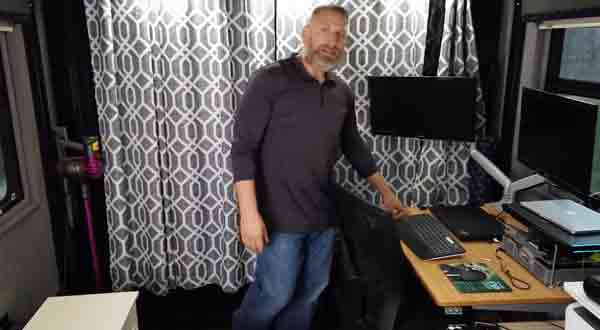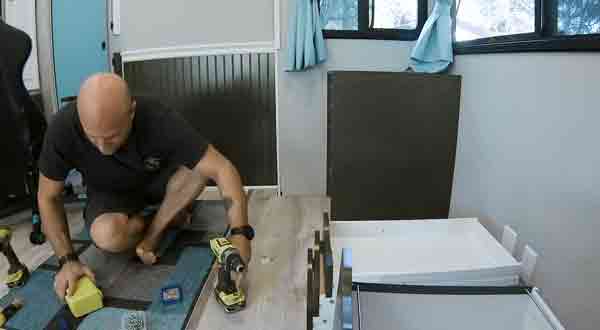Wouldn’t it be great to have your very own RV office? Well the good news is you can reorganize an RV bunkhouse and fill it with office stuffs. Setting up an office in your RV is not as difficult as it seems provided you take the appropriate steps.
18 Important Things To Attach RV With Office Space

Before you renovate your RV, make sure that you’ve got a detailed plan of what the office will look like. Here’s what you do: prepare a list of the features you want and see if your RV has the capability to handle it.
Here are some suggestions.
- Set up a workspace that is dedicated to office work. Don’t put anything there that won’t make you productive.
- Choose a spot in the RV that is quiet so you can concentrate on work.
- The location must have convenient access to wiring so you can set up your equipment.
- Your desk, chair and computer must be ergonomically sound. This is necessary so you can work in comfort.
If there is anything else you want to add to the office, include it in your list. Have everything in your list now so you don’t have to worry about adding it later.
Materials You’ll Need
- Plywood for the floor and desk
- Wood stain
- Tension curtain rod
- Curtains
- Window cover supplies
- Sandpaper
- Screws
- Cedar shims
- Cedar board
These supplies are suggestions only. You may not need all of them or you may need more depending on the kind of work you do. We also didn’t specify the wood size and other numbers because it will vary from RV to RV. You’ll figure out the measurements yourself.
You’ll also need office supplies. We have prepared a list for that too elsewhere in this guide. For now you should focus on creating office space.
1. Dismantling and Removing the Bunk Beds
This is a two man job and is the most time consuming element of the process. You may need to take off the lower bunk window cover and a light fixture or two. Store the bunk beds just in case you decide to sell the RV.
2. Disconnecting the DVD Monitor Wires
Turn off the DVDs if you haven’t already. Most likely the lower monitor needs to be removed along with the bunker beds. You can keep the ceiling monitor if you like. Turn the power source off including the fuse breaker switch.
Look for the wires connecting the power source and DVD and disconnect it. Use a masking tape to label the wires and apply electrical tape to seal the caps.
Be careful when you disconnect the wires. Take care so it doesn’t affect any of the electrical connections in the RV. If you’re not sure which wire is connected to where, let an electrician take care of it.
3. Removing and Inspecting the Bunk Floor
Check the floor if it is durable enough to support an office desk, chair and other items you plan to put there. Add more support if necessary.
The bunk floor is easy enough to remove in most RVs. Take a good long look at it and decide how much support will be needed for your office. Once you get an idea you can proceed with getting the right material.
4. Measuring Up the Wood We Needed for the Office
Use a tape measure to get the figures needed for the floor and desk support. Sketch where the supports will be and use that as a guide when adding the wood.
5. A Trip to the Hardware Store for Supplies and Wood Cuts
Once you’ve got all the measurements, go to the hardware store and buy the necessary supplies. Specify the wood measurements and the store personnel should cut the wood for you.
For the desk and floor use 3/4 inch plywood sheet, and for the support use cedar. Cedar is a good choice because it is durable yet light. There are other wood materials that you can use, but plywood is ideal in most cases.
6. Sanding and Staining the Wood
Sand the floor and desk as smooth as you like. Make sure to round off the corners to prevent injury. You’ll also want the floor edges rounded off so it doesn’t scratch the wall. There are a lot of different sandpapers ranging from coarse to very fine. The choice is up to you.
Apply paint or wood stain, it’s your choice. Follow the instructions and let the wood dry completely before using the furniture.
If you bought a desk it’s already painted and stained so you just need to position it. If you want to do the paint job yourself, paint outside the RV where there is plenty of ventilation.
7. Finishing the Floor with a Matching Vinyl Laminate Tile
Vinyl laminate tiles add a nice, professional touch. If you don’t know how to install tiles, hire a professional to do it. If you want to do it yourself, make certain to apply enough adhesive so the floor sticks.
8. Installing the Desk and Floor in the RV
Now that you’ve got an RV with office space it’s time to put the floor and desk in position. Attach the desk onto the supports and install the floor. Again this is something you can do yourself or have a professional do it for you.
Another Resource: Six Ways to Get Furniture Through RV Doors
9. The Finishing Touches That Complete the Project
The hard part is over. Now you just add items that will complete your office. This is a matter of personal preference, so make a list of the essential stuff. For instance you may want to install an ergonomic keyboard tray for ease of use.
You may also install covers to add privacy along the lower bunk window. Just get some fabric, foam pad and cardboard and the cover is good to go. At this point you’ll be able to add any trimmings or accessories that will make working more enjoyable.
10. How Long Did It Take?
The whole thing shouldn’t take more than a week to complete. The man hours will be anywhere from 15 to 20 hours. This is just an estimate as total time will depend on the size of your RV, your skills and how many people are working with you.
11. Total Cost
The cost should be more or less $200. It will probably be less if you’ve got most of the tools already (glue, masking tape, electrical tape, wires, nuts and bolts, brush, tape measure).
12. RV Office Necessities
So now that your office has been set up it’s time to get your office supplies ready. The following are the minimum required so if you’ve got other items in mind just add them.
13. Mobile Phone
This one is necessity whether you’re on an RV or not. Make sure your phone has all the apps you need and that it is fully charged. Don’t forget to bring a charger.
Choose a mobile phone that has roaming and unlimited long distance calls. If it’s available in one package all the better so you don’t have to pay extra. With these two features you’ll be able to talk to anyone for as long as needed.
14. Computer
Some points to keep in mind.
- There are basically three types, desktops, laptops and notebooks. Notebooks may be too small for office work while a desktop could take up too much space. Laptops offer a nice compromise. If you have the space for a desktop however then go for it.
- Back up your files on an external hard drive or cloud. In case your computer crashes you’ll still be able to work.
- Get a computer desk if possible. Theoretically any desk will do, but a computer desk is designed specifically for this purpose.
- A height adjustable seat is ideal to avoid neck strain.
15. Internet Access
If you need continuous Internet access you have several options.
- A satellite Internet service
- A portable hotspot device for fast internet access
- Get a mobile phone that offers Internet access. Unlimited web browsing packages are now available.
- There are USB Internet cards that give you Internet access once it’s plugged into your computer. You can get these from mobile phone providers.
- There are of course free Wi-Fi hotspots throughout the country. While you can get access in Internet cafes, truck stops and hotels they won’t always be available so you’ve got to have a primary source.
16. Digital Camera
You’ll be traveling all over the country so why not get a high quality digital camera and take photos?
- For simple quick photos, a point and click camera will suffice.
- There are sophisticated digital SLR cameras if you want more options.
- Your mobile phone has a camera so you can use that too. What’s more you can download free photo editing apps to add text, effects and share it with your friends.
17. All-In-One Wireless Printer
As the name suggests, an all in one wireless printer can print, scan and copy. With one of these you’ll get more things done without separate devices eating up desk space. There are different types of printers so do some research to find the ideal model.
18. Fax Options
There are several instances wherein you’’ll need to fax someone. If you feel there’s a need for fax, there are many services that allow you to receive and send faxes. There are services you can sign up for so it’s just a matter of finding the right one.
How To Work From An RV Office In 5 Steps?
You have taken your RV office ideas and turned them into reality. Now here are some tips to maximize your productivity.
1. Create a Work Oriented Itinerary
If you’re going to do a lot of work, set up your route so it takes you along Wi-Fi hotspots, printing facilities, shipping stations etc.
If you work in sales, make stops at expos, fairs and similar events. This gives you the perfect opportunity to promote your products and/or services.
2. Set up and Follow a Work Schedule
Even though you’re in an RV you’ll still need to work. Organize your daily activities, work schedule and tasks, and stick to them. If it’s time for work, focus solely on work so when you’re done you can spend the rest of the day how you want it.
3. How Reliable is Your Internet Access?
We mentioned this earlier but it bears repeating. Internet access is crucial for mobile office work and communications. Having a primary Internet source is essential, but you’ll also need public Wi-Fi as backup.
4. Set Up a Functional Workspace
Your mobile office is only as good as the workspace you’ve set up so make sure you’re productive. While RVs are recreational vehicles you can use the steps given earlier to turn it into a workable office.
The key to a well designed RV office is to include all the essentials without going overboard. Don’t leave out anything that you’ll need but don’t stuff your office either.
Before you hit the road, check your inventory to ensure that you’ve got all the supplies you need.
One of the most common mistakes people make is assuming that as long as you’ve got a laptop you can work anywhere. It’s true you can use a laptop anywhere on your RV, but it’s better if you have a dedicated space for it.
5. Market Yourself
If you’re using your RV for business, you can use the vehicle to promote it. You could for example, paint the RV to market and promote your product or service. You can do the paint job yourself or hire a professional to do it.
Be careful with the advertisement however, as it is not allowed in some parks. Don’t be so blatant when advertising and you should be all right.
Turning your RV into a mobile office is a straightforward process. It does take some time especially the part where you overhaul the bunk beds and turn it into office space. But if you’ve got everything planned you’ll be able to get things done.



Leave a Reply